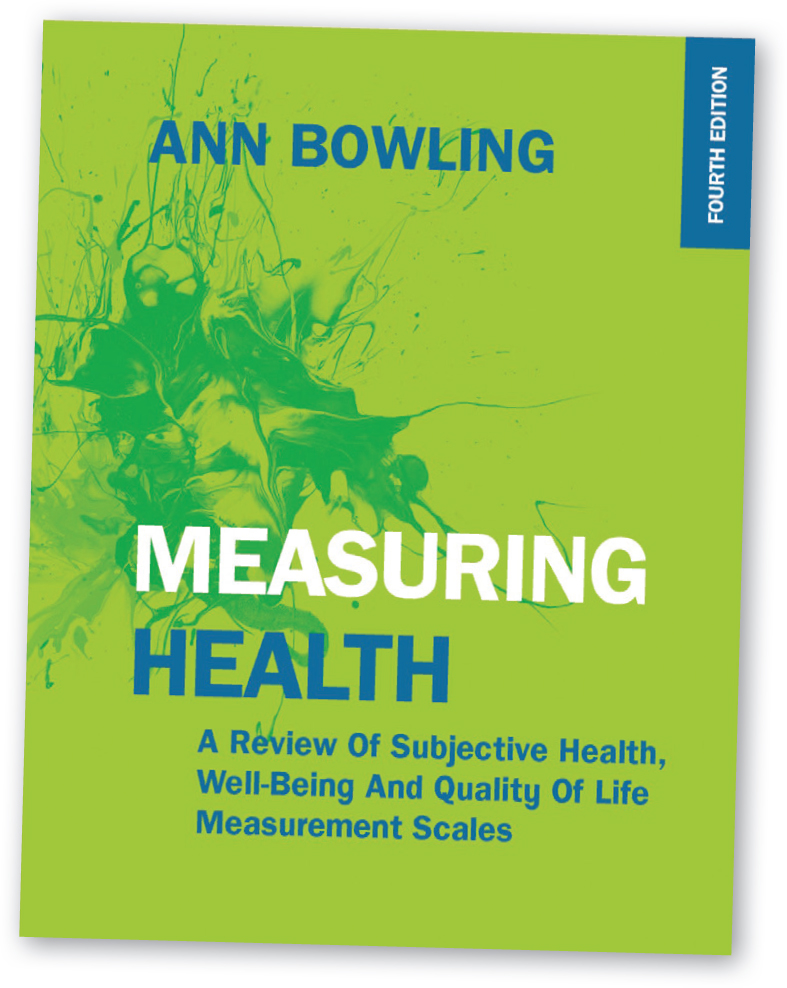Over the past 12 months, there has been an increased focus on mental health in the media, spearheaded by no less than the future king of England via the ‘Heads Together’ initiative. We are being constantly reminded that there is no place for stigma or prejudice against mental illness. Most ambulance services are promoting mental health and wellbeing within their workforce, who are themselves increasingly attending incidences of mental health presenting patients. For this reason, Measuring Health: A Review of Subjective Health, Well-being and Quality of Life Measurement Scales by Ann Bowling may have a high degree of relevance to the practising clinician.
Before embarking on a journey through the complex world of measurement scales, there are no less than 115 acronyms abbreviated for you, not to mention 51 accompanying references. At first this information is a little overwhelming; however, it becomes essential for understanding and serves as a good resource if you intend to do further reading. This sets the tone for what is to come; a format which analyses nearly a hundred measurement scales, focusing on the scoring method, validity, and reliability and, in some cases, a useful example is given. This doesn't necessarily make for easy reading—the text is littered heavily with academic references and numerical data. Having said that, it is also packed with valuable information which provides a good insight into specifics of each measurement scale.
The text begins by analysing concepts behind what health and wellbeing are, and the challenges faced when trying to measure it. Aspects such as accuracy, honesty of the respondent's answers, and thorough testing of the scale are covered to present a balanced account of the scale being discussed. These are all backed by academic references, providing details of the numbers involved in previous studies, validating any claims made.
The format of the book is outlined in the second chapter, which also provides a useful reference point as you make your way through the book and through each measurement scale.
From this point on, you are immersed in a world of indexes, functional charts, questionnaires and inventories; all of which are analysed in the same format and, despite the reasonably complex nature of the subject, in a coherent and consistent format which is repeated with each featured scale.
If you are investigating health and wellbeing, this book would be a vital resource. A frontline paramedic may not immediately find this book relevant to practice owing to the in-depth nature of some of the scales. For example, a questionnaire covering the broader quality of life may not seem relevant to a responding emergency crew. However, there are some pertinent points raised; in particular, the direct link between accessing social support and patient mortality rates gives some food for thought when delivering holistic care to the low-acuity patient.
Chapters have been assigned to mental health, wellbeing, and accessing social support—all subjects of growing significance to paramedic practice given the increased pressures experienced by frontline staff.

There is a strong bank of evidence provided which suggests social relationships and activities are seen as one of the most important areas of life. This topic is covered comprehensively and the book goes on to delve into the association between having a good social capital and lower mortality rates, as well as better self-related health. Facilitating access to social support and reducing loneliness may not be the first thought of a paramedic. However, seizing the opportunity to make every contact count in the long term may actually prolong life, as well as reduce the need for further ambulance attendances. This brings to mind the ‘frequent callers’ which all ambulance trusts endeavour to address and reduce. In addition, this is especially relevant given the consistent increase in call numbers. Edwards et al (2015) report an annual growth of 6.5% in call volume to the ambulance service, and cites one particular study suggesting that 53.7% of calls were inappropriate, often generated by repeat callers (Palazzo, 1999). This also raises the question, could—or indeed should—frontline ambulance clinicians be signposting frequent callers towards positive social networks?
Each scale is explained and broken down into the methods of scoring, validity and reliability. However, it is the short introduction preceding these which you find yourself drawn to. A succinct account of the measurement scale is given, including its history and information on the concept in general. This allows the reader to progress through the text for the finer detail or filter the scale out and continue to source something more relevant.
Where the text addresses psychological ill-being and distress, it also presents an array of measurement scales with the potential to form part of a patient assessment. For example, a challenge often faced by ambulance clinicians is gauging whether a patient presenting with a mental health condition requires acute intervention or is safe to discharge. There are a number of anxiety and depression scales which could assist in the assessment of such a patient and give a deeper insight into their current state of mind. Although the full scale is not always given, short examples containing some of the details are, which are just as useful. In fact, given the complex nature of some of the scales, this brief overview provides enough detail to the reader, giving insight and prompting further reading if desired.
In summary, you can use these scales in various scenarios. If you are unsure if you are happy at work, then you should be aware that happiness is a ‘transitory mood of gaiety and elation’. Next time you're in the mess room and you hear the familiar phrase ‘moral has never been so low’, you can ask ‘is that according to the “delighted–terrible faces scale” or the “Tennessee self-concept scale”?’

